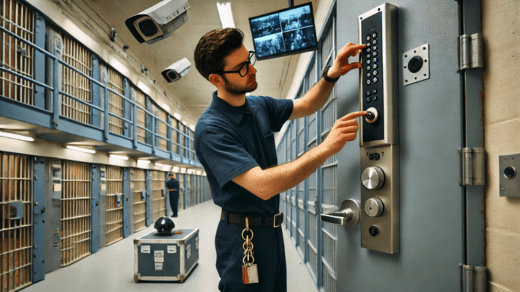The Battle Against Time How Security Detention Equipment Contractors Prevent Wear and Tear
Every lock, hinge, and bolt inside a detention facility is under constant pressure. Daily use, impact, and environmental factors put security fixtures to the test, making durability a top priority. Detention equipment contractors play a critical role in keeping these components intact, using advanced materials and engineering to ensure safety never fails.
High-Stress Hinges Designed to Withstand Repeated Impact
Doors in detention facilities are not like standard doors. They are slammed, kicked, and pushed repeatedly, making hinges one of the most vulnerable points in any security setup. Regular hinges would weaken under such conditions, but high-stress hinges are specifically engineered to absorb repeated impact without failing. Detention equipment contractors install reinforced hinges that distribute force evenly, preventing stress fractures and warping over time.
These hinges often feature ball-bearing systems or concealed pivot designs that reduce friction, minimizing wear and tear. Some even incorporate self-lubricating materials to extend their lifespan, ensuring smooth operation without constant maintenance. Security detention equipment contractors know that a malfunctioning hinge is a security risk, which is why they use only the toughest materials and designs to keep doors secure and operational.
Corrosion-Resistant Alloys That Extend the Lifespan of Security Fixtures
Rust and corrosion are silent threats to security infrastructure. Moisture, temperature changes, and chemical exposure can degrade metal over time, weakening locks, bars, and other critical fixtures. To combat this, detention equipment contractors use high-grade, corrosion-resistant alloys that withstand harsh conditions. Stainless steel, zinc-coated metals, and specialized composite materials prevent oxidation, ensuring long-term durability.
The choice of materials is especially important in high-humidity environments, where moisture can seep into fixtures and cause structural weakening. Security detention equipment contractors apply protective coatings that add an extra layer of defense, preventing rust from taking hold. This approach not only extends the lifespan of security equipment but also reduces the need for frequent replacements, saving facilities time and resources in the long run.
Tamper-Proof Fasteners That Prevent Loosening Over Time
A single loose bolt can compromise security, making fasteners a critical part of detention facility design. Standard screws and bolts can loosen due to vibration, repeated force, or even intentional tampering. That’s why detention equipment contractors rely on tamper-proof fasteners designed to stay in place under extreme conditions.
These fasteners feature unique head designs that require specialized tools for removal, preventing unauthorized access. Some are made with locking threads that resist loosening from constant movement. By securing key structural components with these advanced fasteners, security detention equipment contractors ensure that doors, barriers, and fixtures remain intact, no matter how much stress they endure.
Precision Welding Techniques That Strengthen Critical Connection Points
Welds are often the weakest link in a security setup, especially if they are not executed properly. Poor welding can lead to cracks, weak joints, and eventual failure under pressure. Detention equipment contractors use precision welding techniques to reinforce connection points, ensuring that every joint can handle high levels of force without breaking.
Techniques such as full-penetration welding and robotic welding systems create seamless, high-strength bonds that last. Security detention equipment contractors also conduct rigorous inspections, using ultrasonic testing and X-ray analysis to detect hidden flaws. This attention to detail guarantees that every welded component contributes to the overall security of the facility, preventing potential vulnerabilities.
Routine Maintenance Strategies That Catch Problems Before They Escalate
Even the most durable security fixtures require regular maintenance to stay in top condition. A proactive approach to maintenance prevents small issues from turning into costly repairs or security risks. Detention equipment contractors implement detailed inspection routines, checking for signs of wear, misalignment, and material fatigue.
Routine maintenance includes lubricating moving parts, tightening fasteners, and replacing worn components before they fail. Security detention equipment contractors also provide facility staff with training on early warning signs, ensuring that potential problems are addressed before they become serious threats. These strategies not only prolong the life of detention equipment but also maintain the integrity of the facility’s security systems.
Impact-Absorbing Materials That Reduce Structural Fatigue
Repeated impacts from doors slamming, equipment moving, and daily activity cause gradual weakening of security structures. Over time, this stress leads to cracks, warping, and failure of critical components. To combat this, detention equipment contractors use impact-absorbing materials that distribute force more evenly, reducing strain on structural elements.
Rubberized coatings, reinforced polymer components, and specialized metal alloys help absorb shock, preventing long-term damage. Security detention equipment contractors strategically install these materials in high-impact areas, ensuring that the facility remains structurally sound despite constant use. By integrating impact-resistant materials, they enhance both safety and longevity, minimizing the need for frequent repairs.

